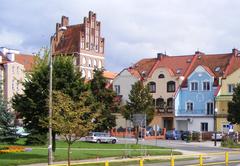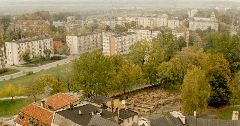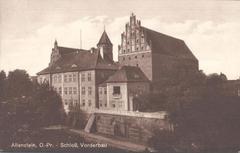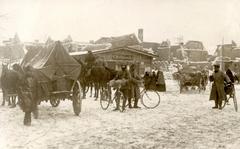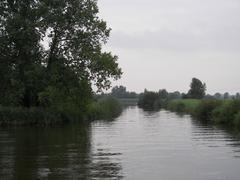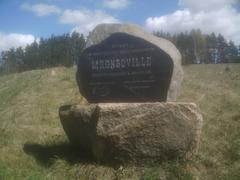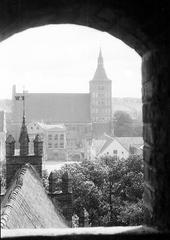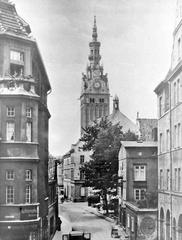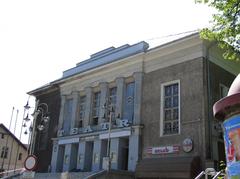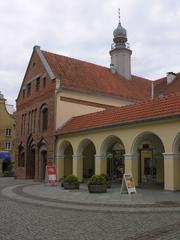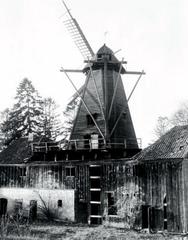
High Gate Olsztyn: Visiting Hours, Tickets, and Travel Guide
Date: 04/07/2025
Introduction
The High Gate (Polish: Brama Górna or Wysoka Brama) in Olsztyn stands as one of the city’s most significant medieval landmarks and an enduring icon of Gothic architecture in northern Poland. Built in the 14th century as part of the original city fortifications by the Teutonic Knights, it is the only surviving city gate and offers visitors a direct connection to Olsztyn’s storied past. With its imposing brick façade, striking pointed arches, and rich decorative elements, the High Gate is not only a historical monument but also a vibrant cultural site, welcoming travelers, history enthusiasts, and families alike.
This guide provides detailed insights into the High Gate’s history, architectural features, visiting hours, ticketing, accessibility, and practical travel tips. Whether you are eager to explore Olsztyn’s medieval heritage, capture the perfect photograph, or attend local festivals, this guide ensures a well-informed and memorable visit (StayPoland; Finding Poland; Evendo).
Table of Contents
- High Gate’s Origins and Medieval Role
- Architectural Features and Preservation
- Visiting Hours, Tickets, and Accessibility
- Travel Tips and Nearby Attractions
- Cultural Significance and Events
- Frequently Asked Questions (FAQ)
- Practical Summary and Visit Tips
- References
High Gate’s Origins and Medieval Role
Constructed in the 14th century, the High Gate was a crucial element of Olsztyn’s defensive system, serving as the main northern entrance to the city. The Teutonic Knights designed it to control access, oversee trade routes, and protect against invasion. As part of a comprehensive network of walls, towers, and gates, the High Gate’s strategic position allowed for effective defense and monitoring of the surrounding area (StayPoland; Lonely Planet).
Historically, the gate also played a vital role in commerce, as all goods and travelers entering the city passed through its formidable archway. Over the centuries, it has served various functions, including as an armory, prison, and police station, reflecting Olsztyn’s evolving urban landscape.
Architectural Features and Preservation
The High Gate exemplifies Brick Gothic architecture, characterized by:
- Red Brick Construction: The use of regional red bricks arranged in decorative patterns, contributing to both strength and aesthetic appeal.
- Pointed Arches & Stepped Gables: Hallmarks of Gothic design, enhancing both defense and visual prominence.
- Tall, Rectangular Tower: Measuring approximately 20–23 meters in height with four main storeys and a distinctive gabled fifth floor.
- Defensive Elements: Arrow slits and narrow windows for observation and protection, heavy wooden doors, and a portcullis (historically).
- Effigy of Our Lady Queen of Peace: A glass mosaic gifted by Pope John Paul II, set in a niche facing the Old Town.
- Bronze Effigy of John Paul II: Located on the gate’s walls, commemorating the Pope’s legacy.
Although the other two original gates (Lower and Mill Gates) have not survived, the High Gate remains remarkably well-preserved, thanks to restoration work in the 19th and 20th centuries. It retains much of its historic fabric despite adaptations over time, including use as a residential space and guest accommodations (Eurob; Polskieszlaki).
Visiting Hours, Tickets, and Accessibility
Visiting Hours
- Exterior and Archway: The High Gate’s archway and exterior are freely accessible 24/7.
- Interior Access: The interior is privately operated as the Wysoka Brama Hotel and the Prosto restaurant. Public access inside is limited to hotel guests and restaurant patrons.
Tickets
- General Access: Walking through the archway and viewing the exterior is free.
- Interior Access: No separate ticket is required, but you must be a hotel guest or dine at the Prosto restaurant to enter.
Guided Tours
While there are no official tours of the High Gate’s interior, local operators offer walking tours that include the gate as a highlight. These tours provide valuable historical and architectural context (Evendo).
Accessibility
- Archway and Surroundings: The ground level is accessible to all, though the surrounding Old Town features cobblestone streets that may pose minor challenges for visitors with mobility needs.
- Upper Floors: As part of the hotel, the upper floors may not be fully accessible.
- Facilities: Nearby tourist centers offer accessible restrooms and ramps.
Travel Tips and Nearby Attractions
Getting There:
- On Foot: The gate is centrally located in Olsztyn’s Old Town, easily reached from the city center.
- Public Transport: Tram and bus routes (notably Tram Stop No. 1) are nearby, as are parking options outside the Old Town.
- By Car: Limited parking is available nearby; consider using public transport during busy periods.
Nearby Attractions:
- Olsztyn Castle: Home to the Museum of Warmia and Masuria.
- St. James’ Cathedral: A prominent Gothic church adjacent to preserved city walls.
- Old Town Hall & Market Square: Vibrant areas for dining, shopping, and cultural experiences.
- Ukiel Lake: A scenic spot for relaxation and recreation.
Photography: The High Gate’s façade is especially photogenic at sunrise and sunset. Capture views from both sides for different perspectives.
Best Time to Visit: April–October offers the most pleasant weather. Summer is lively but can be crowded; early autumn provides a quieter atmosphere.
Cultural Significance and Events
The High Gate is more than a historical monument—it is a living symbol of Olsztyn’s resilience and civic pride (Best Pub Crawl). It frequently serves as the backdrop for city parades, festivals (such as Olsztyńskie Lato Artystyczne and the Olsztyn Green Festival), and public gatherings, playing an active role in the city’s cultural life (The Unique Poland). The gate’s image appears in local art, literature, and promotional materials, reinforcing its status as an emblem of Olsztyn’s heritage (Polskabee; Facts.net).
Frequently Asked Questions (FAQ)
Q: Is there an entrance fee to visit the High Gate?
A: No, viewing the exterior and walking through the archway is free.
Q: Can I visit the interior of the High Gate?
A: Interior access is limited to hotel guests and restaurant patrons.
Q: Are guided tours available?
A: Yes, local operators offer walking tours of the Old Town, including the High Gate.
Q: Is the High Gate accessible for people with disabilities?
A: The archway and surrounding areas are accessible, but the upper floors may not be.
Q: What are the best times to visit?
A: Late spring through early autumn for optimal weather and event opportunities.
Q: Are there events held at the High Gate?
A: Yes, especially during summer festivals and cultural celebrations.
Practical Summary and Visit Tips
- The High Gate is the only surviving gate from Olsztyn’s original medieval fortifications, exemplifying Gothic architecture.
- Exterior access is free and available at any time.
- Interior access requires booking a hotel stay or dining at the on-site restaurant.
- The gate is centrally located, with easy access by foot, public transport, or car.
- Combine your visit with nearby landmarks like Olsztyn Castle and St. James’ Cathedral.
- Respect the monument and help preserve its legacy for future generations.
Map and Visuals:
Include images of the High Gate at sunrise and sunset, and an interactive map of Olsztyn’s Old Town for orientation.
References and Further Reading
- StayPoland – About Olsztyn
- Finding Poland – Top Things to Do in Olsztyn
- Evendo – Upper Gate in the Old Town
- The Unique Poland – 10 Top Things to Do in Olsztyn
- Eurob – Olsztyn
- Polskieszlaki – Olsztyn
- Best Pub Crawl – Cultural Significance of Olsztyn
- Polskabee – Olsztyn’s History
- Facts.net – Olsztyn
- Explorecity.life – Olsztyn
- Wikimedia Commons – High Gate in Olsztyn
- Official Olsztyn Tourism Website
- Poland Travel Tours – High Gate
- Warmian-Masurian Voivodeship Travel Guide


